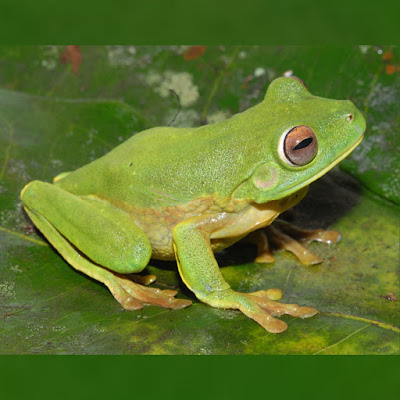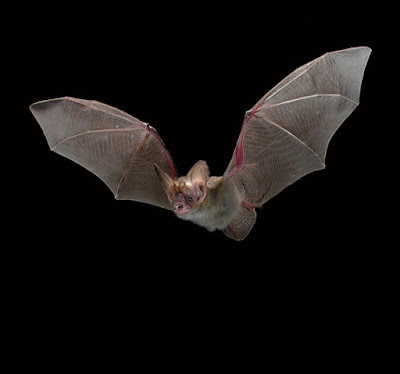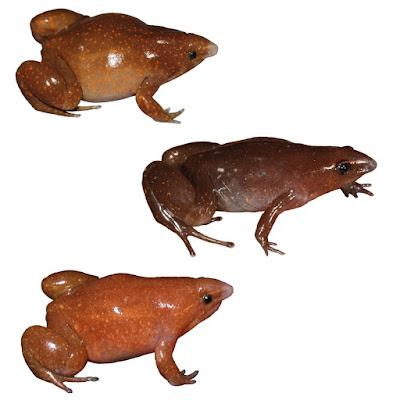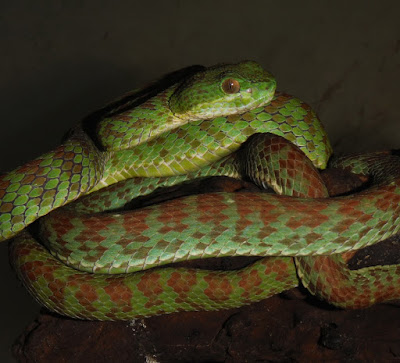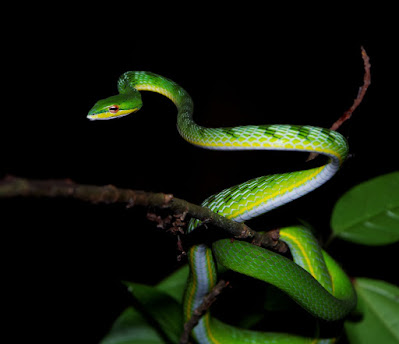[Most Recent Entries] [Calendar View]
Thursday, May 20th, 2021
| Time | Event | ||||||
| 2:03a | [Herpetology • 2021] Litoria lubisi • A New Species of Large Green Treefrog (Pelodryadidae, Litoria) from Papua, Indonesia
Abstract We describe a new species of large green treefrog from southern Papua Province, Indonesia. Litoria lubisi sp. nov. is placed in the L. infrafrenata Group based on its size, colouration and configuration of hand webbing, but differs from other members of this group in aspects of body size and proportions, extent of hand webbing, colouration and male advertisement call. Litoria lubisi sp. nov. occurs in close proximity to two other species in the L. infrafrenata Group, emphasising an until-recently overlooked pattern that multiple species of large, arboreal Litoria have overlapping distributions across much of the lowlands of southern New Guinea. Keywords: Pelodryadidae, Litoria graminea Group, Litoria infrafrenata Group, New Guinea, swamp forests Paul Oliver. Rainer Günther, Burhan Tjaturadi and Stephen J. Richards. 2021. A New Species of Large Green Treefrog (Litoria, Pelodryadidae) from Papua, Indonesia. Zootaxa. 4903(1); 117–126. DOI: 10.11646/zootaxa.4903.1.7 | ||||||
| 4:20a | [Mammalogy • 2021] Nyctophilus holtorum • A New Bat Species (Chiroptera: Vespertilionidae) from southwestern Western Australia, previously Assigned to Gould’s Long-eared Bat Nyctophilus gouldi Tomes, 1858
Abstract A distributional isolate in southwestern Western Australia previously assigned to Gould’s Long-eared Bat Nyctophilus gouldi Tomes, 1858 is demonstrated to be a distinct and previously unnamed cryptic species, based on a lack of monophyly with eastern populations and substantial DNA sequence divergence (5.0 %) at the mitochondrial gene COI. Morphologically both species are alike and overlap in all measured characters but differ in braincase shape. The new species has one of the most restricted geographic ranges of any Australian Vespertilionidae and aspects of its ecology make it vulnerable to human impacts.
Nyctophilus holtorum sp. nov. Diagnosis: A species of medium body size for the genus, closely resembling N. gouldi sensu stricto in external appearance, cranial and dental morphology but differs by an average sequence divergence of 5.0 % at the mitochondrial gene COI. It differs further in that the braincase tends to be broader for N. gouldi sensu stricto of equivalent GSL (Figs 3 and 4), as reflected by greater MASB (Fig. 3a); the anterior of the braincase tends to be more inflated laterally, and the skull tends to be relatively shorter e.g., FA vs. GSL (Fig. 3c) and FA vs. CM3 (Fig. 3d). ... Etymology. Named in honour of the late Dr John Holt and Mrs Mary Holt in recognition of their generous long-term support of Australian biodiversity research and conservation. Distribution. Restricted to four IBRA regions in far southwestern Western Australia (Fig. 6). We are aware of only one voucher-based locality record from the southern Avon Wheatbelt (from the Tambellup district), a region that has been extensively cleared of native vegetation. The specimen (WAM M.593) was collected by F. R. Bradshaw and registered in 1923 (probably Frederick Robert Bradshaw of Tambellup, Whittell, 1954). The species is primarily found in taller marri and jarrah forests with a dense shrubby understory. Two other Nyctophilus species are sympatric with N. holtorum sp. nov., N. major and N. geoffroyi. Common name. Holt’s Long-eared Bat. Harry E. Parnaby, Andrew G. King and Mark D. B. Eldridge. 2021. A New Bat Species from southwestern Western Australia, previously Assigned to Gould’s Long-eared Bat Nyctophilus gouldi Tomes, 1858. Records of the Australian Museum. 73(1); 53–66. DOI: 10.3853/j.2201-4349.73.2021.1766 Holt’s Long-eared Bat: A new cryptic species discovered in Western Australia | ||||||
| 11:39a | [Herpetology • 2021] Synapturanus zombie, S. mesomorphus & S. ajuricaba • Comparative Osteology of the Fossorial Frogs of the Genus Synapturanus (Anura, Microhylidae) with the Description of Three New Species from the Eastern Guiana Shield Abstract The genus Synapturanus includes three nominal species of fossorial Amazonian frogs. A previous study combining molecular, morphological and acoustic data suggested that there may be six times more species than currently recognized. Herein we describe and name three of these new species and compare their osteology. Synapturanus zombie sp. nov. occurs in French Guiana and Amapá (Brazil), S. mesomorphus sp. nov. in Guyana and adjacent Venezuela, and S. ajuricaba sp. nov. in the northern part of the Brazilian states of Amazonas and Pará. These species are readily differentiated from congeners by a combination of external morphological characters such as body size, development of fringes on fingers and coloration, by advertisement call variables, and by osteological traits. Along with osteological reinforcement of the skull, atlas and scapular region, the reduction of the size of phalanges, more developed fringes on fingers, smaller eyes and larger body size, altogether suggest an overall increase of the fossorial habits in the easternmost species. In contrast, the relatively conserved morphology of the posterior part of the body across the genus suggests that fossoriality mostly involves the anterior part. Furthermore, the fusion of tarsal bones in the species of the western clade may indicate locomotory adaptation to more epigean habits. Keywords: Amazonia, Amphibia, Integrative taxonomy, Morphology, Tomography Synapturanus zombie sp. nov Synapturanus mirandaribeiroi Nelson and Lescure, 1975. Synapturanus sp. “Eastern Guianas” Vacher et al., 2020; Fouquet et al., 2021 Etymology: The specific epithet is a noun in apposition referring to zombies, fictional undead corporeal revenants, originating from Haitian folklore and omnipresent in pop culture movies. The call of this species is only heard during and after heavy rain showers, when herpetologists are often not properly equipped, thus ending up soaked and digging with their bare hands in the mud in the midst of thunderstorms, reminiscent of zombies extracting themselves from the ground. Synapturanus mesomorphus sp. nov Synapturanus mirandaribeiroi Nelson and Lescure, 1975; Ernst et al., 2005. Synapturanus salseri Kok and Kalamandeen, 2008; Cole et al., 2013. Synapturanus sp. “Guyana” Vacher et al., 2020; Fouquet et al., 2021 Etymology: The specific epithet comes from the Greek mesos (middle, intermediate) and morphē (sort, appearance, form) and refers to the intermediate morphology of the species between the easternmost species of the eastern clade and the species of the western clade (Fouquet et al., 2021). Synapturanus ajuricaba sp. nov. Synapturanus mirandaribeiroi Nelson and Lescure, 1975. Synapturanus salseri Lima et al., 2012; Peloso et al., 2015 Synapturanus cf. salseri Menin et al., 2007. Synapturanus sp. “Manaus” Vacher et al., 2020; Fouquet et al., 2021 Etymology: The specific name ajuricaba is used as a noun in apposition and is given as a reference to the legendary indigenous figure, Ajuricaba, a prominent leader of the Manaós indigenous people—considered extinct. They were one of the most important tribes of the Rio Negro. Ajuricaba led several incursions by the Manaós and allied groups against European settlements in the Rio Negro region. For his effort and leadership, he became one of the symbols of indigenous resistance against European colonization. Ajuricaba was eventually captured and was to be conducted to Belém, probably to be enslaved. History tells that during his transport to the capital, while still in chains, Ajuricaba and his men rebelled against captors, killing several of them. Eventually losing the battle, the survivors, including Ajuricaba, jumped into the waters of the Amazon river and were never seen again. For additional details about this important indigenous figure, see Souza (2019). Antoine Fouquet, Killian Leblanc, Anne-Claire Fabre, Miguel T. Rodrigues, Marcelo Menin, Elodie A. Courtois, Maël Dewynter, Monique Hölting, Raffael Ernst, Pedro Peloso and Philippe J.R. Kok. 2021. Comparative Osteology of the Fossorial Frogs of the Genus Synapturanus (Anura, Microhylidae) with the Description of Three New Species from the Eastern Guiana Shield. Zoologischer Anzeiger. In Press. DOI: 10.1016/j.jcz.2021.05.003 | ||||||
| 11:48a | [Herpetology • 2021] Trimeresurus kuiburi งูหางแห้มกุย • A New Karst-dwelling, Colorful Pitviper (Viperidae: Trimeresurus) from northern Peninsular Thailand
Montri Sumontha, Sunutcha Suntrarachun, Olivier S. G. Pauwels, Parinya Pawangkhanant, Nirut Chomngam, Prapanth Iamwiriyakul and Lawan Chanhome. 2021. A New Karst-dwelling, Colorful Pitviper (Viperidae: Trimeresurus) from northern Peninsular Thailand. Zootaxa. 4974(1); 307–332. DOI: 10.11646/zootaxa.4974.2.4 | ||||||
| 12:06p | [Herpetology • 2021] Ahaetulla rufusoculara • A New Species of Ahaetulla Link, 1807 (Squamata: Colubridae) from the Mekong Delta, Vietnam A new vine snake, genus Ahaetulla, from Soc Trang Province, southern Vietnam is described based on morphological data and nucleotide sequences from COI and Cytb. Ahaetulla rufusoculara sp. nov. is diagnosed by the following morphological characters: bright red eyes; snout without dermal appendage; internasal separated from supralabial by loreal; body scale rows 15-15-13; ventrals 186–190 in males and 182–185 in females; subcaudals 143–153 in males and 128 or 129 in females; 8 (rarely 9) supralabials, fourth and fifth or fourth to sixth entering orbit; 12–14 maxillary teeth; hemipenis short, reaching 6th or 7th SC; cloacal plate divided; dorsum bright green; and yellow or white stripe along the lower flank. The new species differs from its congeners by an uncorrected p-distance in COI and Cytb sequences of at least 7.7% and 7.5%, respectively. Keywords: Reptilia, Ahaetulla rufusoculara, hemipenis, mitochondrial DNA, southern Vietnam, vine snake Ahaetulla rufusoculara Etymology. The specific epithet rufusoculara refers to the red color of the eyes and is derived from the Latin adjective rufus (meaning “red”) and oculus (means “eye”). We recommend “Red-eyed Vine Snake” and “Rắn roi mắt đȯ” as the common English and Vietnamese names of the new species, respectively. Ngon Quang Lam, Tran Thi Anh Thu, Luan Thanh Nguyen, Robert W. Murphy and Sang Ngoc Nguyen. 2021. A New Species of Ahaetulla Link, 1807 (Squamata: Colubridae) from the Mekong Delta, Vietnam. Zootaxa. 4966(3); 290–304. DOI: 10.11646/zootaxa.4966.3.2 |
| << Previous Day |
2021/05/20 [Calendar] |
Next Day >> |
